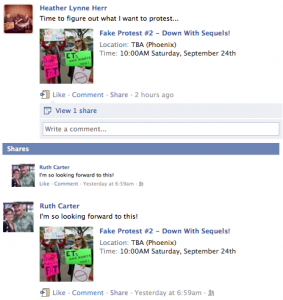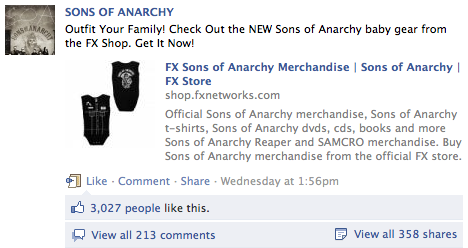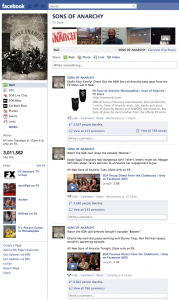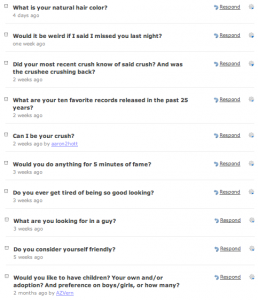Archive for category social media
Facebook Page Engagement Numbers and Quick Competitor Comparisons
Posted by Ms. Herr in social media, social networks, socialmediatoday, the biz side on September 16, 2011
In addition to Likes and Comments, Facebook is now exposing the number of shares a post receives. This number is displayed for both individual user posts, based on that user’s privacy settings, and on Page posts.
There are definite upsides and downsides to the introduction of shares data in its current form for business and brands, who now have an additional qualitative factor on which to evaluate the engagement success of different posts. InsideFacebook has outlined a number of them. In short…
The upside:
- Alert users to the availability of the Share option and increase its usage.
- Give Page admins visibility into what and how often content is reposted (a metric we’ve previously been blind to).
- Identify who is sharing your content (think potential brand advocates).
- Push publishers to actively pursue shares.
The downside:
- Impact of shares on EdgeRank is TBD.
- Share metrics are not (or at least not yet) included in Facebook Insights.
- The repost no longer includes the name of or link back to the source (a major downside for brands).
I think initial excitement over the new shares data point overlooks the fact that some of your most important engagement numbers are right there in the open for all to see. And exposing new data points make your success, or failure, at inspiring your community to action is increasingly public.
Impressions, feedback rates, active users, demographics and daily page likes are all masked behind Insights, visible only to Page admins. The wall is good. Social media performance metrics should enjoy many of the same privacy protections that other business performance metrics do. But consider what is behind the wall, what is in front, and how this affects fan behavior and business intelligence. The exposure of Likes and Comments stands as social proof of how interesting your content is, but it also offers competitors, and the merely curious, a glimpse into how good you are at engaging your community. Now your shares are public too.
Why does this matter? After all competitors can’t see your actual engagement rates, right?
Outsiders may not be able to see your actual impressions or feedback rates, but it’s actually very easy to make an assessment as to how you are performing from an engagement standpoint. I often complete weekly competitor reviews for clients, and I can take a rough measure by comparing interactions to Page Likes. There are services that will do some of this automagically, but the following ‘by hand’ method works well for spot checks.
Add up the total number of Likes and Comments on the last 3 to 5 posts for each Page you’re reviewing (including your own). Divide that by the number of posts you looked at to get the average number of interactions per post, and then divide by the total number of Page Likes. Make sure to use the same sample size for each Page you’re looking at (e.g. last three posts for all Pages).
Interaction Rate = Average (Likes + Comments of last 3 posts) / Total Page Likes
Let’s look at Sons of Anarchy, for example:
Post 1 – 3027 Likes, 213 Comments and 358 Shares = 3598 interactions
Post 2 – 4690 Likes, 533 Comments = 5223 interactions
Post 3 – 6822 Likes, 768 Comments = 7590
Total Page Likes – 3,011,562
(Click image at right to view post data and fan count.)
Interaction Rate = ((3598 + 5223 + 7590) ÷ 3) / 3,011,562
Interaction Rate = 0.18%
Jay Baer made a great point awhile back that on Facebook, your competitive set extends beyond other companies in your industry, but all brands and businesses using Pages. You can apply the calculation above to see how any of these brands are performing.
Shares gives you, and me, and additional data point in determining how your social content is performing.
Skilled Facebook Page admins already know that some posts are better suited for generating Likes, and others comments. Ideally, your content mix includes a number of each to keep the fan experience dynamic and engaging. The introduction of shares to the visible metrics lineup will lead to new post types and strategies.
Social media pros, and your competitors, will be stalking your Page to see what works and what doesn’t.
6 Ingredients for the Secret Sauce: Social Media Best Practices for Big Brands
Posted by Ms. Herr in social media, the biz side on May 13, 2011
This is an expanded version of a guest post that originally appeared on the commpro.biz Thought Leaders blog.
Three years ago, few people would have considered Facebook and YouTube the place to be for big brands wanting to connect with customers. With the decline in traditional media consumption and the explosive growth of social media, any company not already participating in direct conversations with fans and followers are scrambling to get up to speed. Whether you’re dipping your toe into the waters, or revisiting your current approach to social, here are six points to guide your efforts.
Lead with strategy
Your fans and followers want to know the benefit of subscribing to your updates. Whether you’re driving sales, extending customer service or reinforcing the brand lifestyle, social media activities should reinforce your business objectives. Establish your goals up front. Develop content to support your goals. Identify performance indicators that you can use to track what’s working and what isn’t.
Who is doing it well? – American Red Cross exists to provide aid to disaster victimes. Social media has the power to spread messages far and fast, and the Red Cross leverages video, photo, status updates and other social communications to mobilize the public to get involved and inform people about how donations and voluteers are making a difference.
Provide employees with social media guidelines and training
Managing social media for a big brand is dramatically different than maintaing a personal account. Not only are the objectives different, but the functionality within a single social site can differ significantly. Facebook is the most obvious example of this, as Pages and profiles each possess unique attributes. Make sure the team on the front lines has the knowledge they need to manage your brand presence. Then, ensure the rest of your employees possess a basic knowledge of how social media works, what your company policy is and how it affects personal and professional usage.
Who is doing it well? – Kodak is well known for their proactive engagement in social media. Early adopters, they remain passionate about social media done right and publicly share their social media tips and policy (PDF).
Listen, listen, and listen some more
Social media pros will tell you that step number one is listening. The intelligence you gain during a pre-implemention phase will guide your strategy, but the listening doesn’t stop once you’ve launched Facebook, YouTube and a blog. The makeup of your community will change as you grow. The platforms you are using will change. The engagement dynmaics will evolve, presenting new challenges and new opportunities. Listen carefully to what is being said. Separate the feedback gold from the noise. Adjust accordingly, and keep listening.
Let your community have a voice
Social media is social. A YouTube account or blog that has commenting disabled becomes just another one-way marketing broadcast channel. ExactTarget’s Subscribers, Fans and Followers: The Social Break-Up report showed that receiving too many marketing messages is a leading reason people stop following a brand’s social media updates. Leave commenting on, ask your subscribers for their input and respond when they share an opinion. Each comment is a latent touch point, allowing you to build stronger relationships with existing and potential customers.
Who is doing it well? – Starbucks launched My Starbucks Idea, a community site where customers can share, discuss and vote on ideas they’d like to see Starbucks adopt. When Starbucks acts on one of these ideas, the community is the first to know.
Have a plan for responding to negative word of mouth
Every company experiences negative word of mouth, some more than others. This is not a time to run and hide. Show your customers that you are listening. Address the issue at hand and work toward a resolution. Whenever possible, respond publicly and on the site where the complaint first occurred. If online dialogue becomes unproductive or personal information is required, take it offline.
Learn from the successes and failures of others
There are several brands doing social media well. Ford Motor Company, Southwest Airlines (Facebook/Twitter), and Red Bull* have each taken a unique approach to social media, but they’re leaders in their industry and in social media. On the other side of aisle, several brands have experienced failures. Some recover, some don’t. Either way, there are valuable lessons you can apply to your own business.
Success in social media requires a clear focus on your goals and a genuine interest in engaging with customers. Plan, implement, experiment, listen and respond. Whether it’s a greater share of market or improved brand health, you’ll find social media can move help you move the needle on your business objectives.
*Red Bull is a Terralever client.
Congratulations
Your first AWS Elastic Beanstalk Node.js application is now running on your own dedicated environment in the AWS Cloud
This environment is launched with Elastic Beanstalk Node.js Platform
What’s Next?
- AWS Elastic Beanstalk overview
- AWS Elastic Beanstalk concepts
- Deploy an Express Application to AWS Elastic Beanstalk
- Deploy an Express Application with Amazon ElastiCache to AWS Elastic Beanstalk
- Deploy a Geddy Application with Amazon ElastiCache to AWS Elastic Beanstalk
- Customizing and Configuring a Node.js Container
- Working with Logs
News Sites Sleep While San Francisco Riots
Posted by Ms. Herr in social media, the biz side on November 4, 2010
Originally posted to on the Terralever blog November 2, 2010:
Last night around 8 pm, I settled in for Monday Night Football and a nap. I haven’t gotten a lot of sleep lately – work hard, play hard, live hard is common for Terraleverians. I awoke 3 hours later to ESPN SportsCenter and a great segment on the new World Champion San Francisco Giants. This year’s Giants were a scrappy team of misfits that wanted it more than anyone else. As I hopped online to knock off a couple to do items before calling it a night, I stumbled across the #SFriot tag on Twitter. Giants fans’ celebrations had turned dangerous, complete with crowds, bonfires, vandalism and physical violence. Coverage was all over Twitter, as were links to listen in on SFPD scanners in real-time. As I tuned in, all thoughts of sleep went out the window.
Twitter hashtags are great for real-time updates on a trending topic, but painfully limited when you want the background story. Search engines, on the other hand, are great for this. Google search results for “san francisco riots” returned Mashable’s story on the riots in coveted top slot. Mashable’s story was posted within a couple of hours of the first reports, and painted a quick picture of transpiring events by leveraging citizen journalism – documented accounts of news events reported by members of the public.
It would be easy to cite this as yet another example of the power of social media to break and share news quicker than traditional outlets, just as it was during the Hudson River plane crash and the Haiti earthquake. But that’s a rickety bandwagon. Real-time channels can quickly become muddled by virtual onlookers contributing their own commentary on current events. It happened with #SFriot, where jokes about hipsters and social commentary on, of all things, social media culture.
What is compelling about this particular incident is that social and technology news sites, such as Mashable, TechCrunch, and Gawker dominated the results for two of Google search verticals: aggregated web search and news search. Within the aggregated vertical, after the first three results, Google returned results for other riots. Did traditional news outlets not consider last night’s riots significant enough to cover in a timely fashion? Were they all asleep? Or maybe Google just wasn’t sure my interest was current or historical. Changing the search paramaters to San Francisco (instead of local) had no effect on the quantity or ordering of results.
What does it say when Mashable and TechCrunch rank highest for current events and news search? These sites aren’t focused on general public awareness or safety. They are focused on cultural relevance, but from a very niche viewpoint – social media technologies. Mashable’s post was sufficiently grave, but it was written to showcase the real-time nature of social media and citizen journalism.
As a business or individual, your ‘news’ may not be of the scale or nature of last night’s riots, but right about now, you should be thinking how this changes your outreach and coverage strategies when you have a story to tell.
- Is your ‘news’ really news? Determine whether the information you have affects society at large, a local municipality or just your own customer base.
- What sites and sources are most likely to consider your information newsworthy? Is it editorial content for journalists or conversation points for niche-interest sites?
- What, exactly, is the angle that each of your targeted sites is going for? How do you fit?
- Are you presenting your content in a way that aligns with the goals and audiences of your targeted sites?
- Are you in it for the coverage? Or are you interested in building a relationship with the editors and audiences of each outlet?
Answer those questions, and you’ll know whether traditional media will sleep on your news too and if your strategy should focus on social news and citizen media.
Goodbye 12seconds.tv! The Death and Life of Early Adoption in Social Media
Posted by Ms. Herr in marketing & advertising, social media on October 25, 2010
Originally posted to on the Terralever blog October 22, 2010:
![]() Tonight This past Friday, at 8:15pm Pacific Standard Time, the micro-video blogging site 12seconds.tv closes it’s doors forever. Current members are advised to export their videos quickly, or lose them forever. The badges, comments, favorites, bumps, and views stats are not included in the export – they will be lost. As for the people, connections and new friends found in the process of posting, viewing and sharing 12 second videos – hopefully you’ve connected on other platforms, or they too will be lost.
Tonight This past Friday, at 8:15pm Pacific Standard Time, the micro-video blogging site 12seconds.tv closes it’s doors forever. Current members are advised to export their videos quickly, or lose them forever. The badges, comments, favorites, bumps, and views stats are not included in the export – they will be lost. As for the people, connections and new friends found in the process of posting, viewing and sharing 12 second videos – hopefully you’ve connected on other platforms, or they too will be lost.
12seconds.tv was a micro-video blogging site where 12ers shared and engaged with one another around short video clips that were 12 seconds long, exactly. 12seconds used gamification tactics, such as badging and daily challenges to encourage frequent use. They developed a variety of additional features to attract businesses, including 12omercials.
Why didn’t 12seconds.tv catch on? From a user perspective, 12 seconds was simply too short of a time, even for micro-video. Read a 140-character tweet aloud, and it will take you roughly 12 seconds. In spite of the benefits of such brevity, it’s challenging to execute in one take. On Twitter, you can edit text in the field. In video, running long requires you to rerecord, a process that can become frustrating, particularly for the novice or the slightly verbose.
Businesses who avoided the platform probably cited such reasons as it being too soon to know if 12seconds would catch on, too few users, and poor video quality. You could make a valid case for each of these, but too often, such reasons are a symptom of bigger issues – an unfamiliarity with social media, an unwillingness to understand it and aversion to experimentation. There are benefits and risks associated with engaging customers and users in open communication.

A handful of brands were bold enough to experiment with 12seconds, among them:
- M&Ms Racing – Leveraging NASCAR and Kyle Busch fans, the M&Ms Racing 12 Seconds Cup featured a series of mini-competitions, wherein participants responded to each challenge with a 12seconds video.
- Mountain Dew – As part of their larger DEWmocracy campaign, which allowed DEW drinkers to drive the development of three new flavors, Mountain Dew invited fans to create the advertising spots for the new DEWs.
- Adidas – In partnership with the Chelsea Football Club, Adidas sponsored the Chelsea’s 12th Man contest, offering U.S. fans the chance to win a spot on the team, albeit on the bench, during a U.S appearance.
The benefits of getting involved early
It would be easy to construe the news of 12seconds.tv closing as evidence of the risks of investing in a social media channel too early, but I’d advise against that. There are significant advantages to being an early adopter on emerging platforms.
- Gain first mover attention – In a space that is constantly evolving, there’s plenty of room to creatively implement new ideas. If you’re the first one to test something, or you’re the first to try it in a way that is remarkably different than predecessors, you’ll grab the attenion of leading digital media outlets and influencers. If you wait too long to get involved, or if your ideas aren’t unique, you become the copy cat, and there’s nothing pressworthy about that.
- Become the benchmark – Back when Twitter was still pretty niche, Frank Eliason started listening for and responding directly to complaints about Comcast. As @comcastcares, delivered execptional customer service. It wasn’t a flashy campaign. Frank was being helpful. Two years later, it’s still one of the best known and most cited examples for how to do social media listening and response the right way.
- Master the learning curve – Each new platform comes with certain learnings. How are users behaving and engaging with the platform? What are the features? Is there a specific nomenclature and culture that pervades the community? How can businesses get involved? The answers to each of these questions differ considerably by each platform, but if you’re connected and engaged, you’ll start to recognize similarities. Learning to recognize engagement patterns, and feature-based exceptions, are key to leveraging any social media channel.
- Establish yourself as a thought leader – The early adopters of any product or technology often become the people who teach everyone who follows. Experiementing with an emerging social media platform, and sharing that knowledge with others will significantly, and positivitly impact your influence, garnering attention for you and the brand you represent.
Remember, it’s not about you, it’s about your customers. If the people you seek to connect with are playing in a particular social media channel, you should probably give some serious thought to rolling up your pant legs and getting your feet wet.
*If you’d like to leave a comment, please feel free to do so here and/or on the original post on the Terralever blog.
Congratulations
Your first AWS Elastic Beanstalk Node.js application is now running on your own dedicated environment in the AWS Cloud
This environment is launched with Elastic Beanstalk Node.js Platform
What’s Next?
- AWS Elastic Beanstalk overview
- AWS Elastic Beanstalk concepts
- Deploy an Express Application to AWS Elastic Beanstalk
- Deploy an Express Application with Amazon ElastiCache to AWS Elastic Beanstalk
- Deploy a Geddy Application with Amazon ElastiCache to AWS Elastic Beanstalk
- Customizing and Configuring a Node.js Container
- Working with Logs
ask me anything, answer me anything – the formspring.me dilemma
Posted by Ms. Herr in social media, socialmediatoday on May 21, 2010
I’ve made a minor addition to my blog. On the right, right under the search box, you’ll find a formspring.me widget. If you’re not familiar with it, formspring is an application that allows users to send, receive and respond to questions. The default header on the question box is “Ask me anything.” and questions may be authored or asked anonymously (account holders do have the option to disallow anonymous questions).
I signed up for formspring.me approximately 5 months ago. In that time I have received nearly 40 questions. I have answered 10, and each time I scan my inbox, I am faced with the dilemma: Do I want to commit to answering every question that is asked of me? Why wouldn’t I want to answer every question, you ask? Well, take a look at 10 questions sitting quietly in my inbox, waiting for me to answer them.
The questions are overwhelmingly personal. In fact, the only ones I would not consider personal are ten favorite records, five minutes of fame, and consider yourself friendly. The having children question, though highly personal, is one that I’m happy to answer. But many of the others are just, well… odd. They are not they type of questions I was expecting, and some leave me slightly uncomfortable. For example:
Is it weird that you missed me? Maybe not if I no-showed on an event you were expecting me to attend, or if we’re friends but haven’t spoken in awhile. But maybe so if it was a romantic notion, since I haven’t been connected to anyone in that manner for quite some time. Is the question weird? Ummm…kinda. Is the question inappropriate? That depends not only on who is asking (which I don’t know), but also on my intentions for using formspring.
I am a compulsive joiner, often signing up for online applications purely to see what all the fuss is about. I also tend to be very open in both online and offline conversations, frequently talking about subjects and happenings that are not related to my professional career. Thus, in the absence of a stated purpose for using formspring, it would be safe to assume that the purpose is not (or not limited to) professional application (assuming, of course, we ignore for just a minute that part of my job as a social media strategist is to know about things like formspring).
Which questions are appropriate, and which are just plain questionable?
I have no doubt that the more questionable questions are enabled by anonymity, because with anonymity comes freedom. An asker may pose whatever question they choose without fear that they or their intentions will be revealed. They may ask questions that are highly personal not only to me, but also to themselves. I, however, can not answer anonymously, which means I must determine if I want to respond to every question I am asked and how open I want to be in my responses.
Consider that some answers open the door to further questions. The two crush question you see in photo above were submitted only after I answered Who is your secret crush? Consider also that anonymous questions may prompt guarded responses. To a known asker, I might have answered the good looking question with flirtatious banter or sarcastic humor if I knew either to be relevant to my relationship with that individual, but to an anonymous asker, I will likely answer with a relatively unrevealing statement on confidence in one’s appearance answered with a quip about beauty versus brains.
My question(s) to you, particularly to other formspring.me users:
- What is your purpose for using formspring.me?
- How will you approach questions that don’t align with that purpose (too personal, off-topic, etc.)?
- How do you approach questions asked anonymously?
- Would you commit to answering every question that was asked of you?
more writing on social media
Posted by Ms. Herr in blogging, social media, the biz side on March 8, 2010
It’s been a hot minute since I’ve posted here, and it’s been an even hotter minute since I written anything specifically for post on this blog. The lack of new writing here does not mean that I haven’t been writing. Most of my recent work can be found on the Terralever blog, where my focus is social media. I have two newish pieces that you may find interesting.
- Is Facebook helping or hurting your hiring efforts? – Most existing conversations about social media and job hunting address the topic as it impacts job seekers. These conversations either serve as warnings (photos of keg stands will kill your chances of getting hired) or as advice (blogs and microblogs can help you demonstrate your skills and network with the right people). I take a different approach, and instead address how social media impacts a company’s ability to recruit smart new talent.
- Mashable Fans: Pawns in the impressions game – A few weeks ago, Mashable changed their Facebook posting style from simple headlines to phrasing updates as questions</a>. I criticized The Social Media Guide for trying to stimulate fan interaction and conversations, while being noticeably absent from those same conversations. Mashable promptly responded, and you can see their remarks in the comments of the original blog. The company has also continued to experiment with their posting strategy and style, making some positive changes, which I summarize in a follow up post.
Back to this blog, Ms. Herr when online is intended to be the accumulation of all facets of my life, including ruminations on any topic from the personal to the pass times to the professional. More on any and all of those things are in the works.
6 & 1/2 simple tips to extend your social presence in 2010
Posted by Ms. Herr in social media, the biz side on January 6, 2010
Originally posted to the Terralever blog on January 5, 2010:
A new year is synonymous with starts, either on new goals or on older ones that we’d like to take another crack at. Each goal represents a desire to be better than we were last year. A new year is also synonymous with new lists created to make that path toward success a little bit easier.
Whether you just got started in social media or have been playing in the space for years, there are several ways that you can add a little spice, extend your reach, and increase your impact.
1. Grab your name on every social site you can.
You can lay a foundation for continued social engagement by protecting ownership of your brand name, be it your company name or your own name. Sites that allow users to select a unique handle do so on a first come, first served basis, and while some offer restorative action where copyright or trademark infringement is involved, there’s no guarantee that you’ll recover your name in a timely fashion if some other Dick or Jane beat you to the punch bowl. KnowEm and namechk allow you to see where your username has been claimed. Neither tool contains a comprehensive list of all social sites, but they contain most of the major ones and are a great place to start. Signing up for one account is relatively quick; signing up for a dozen can take considerably more time. If you don’t have the time, KnowEm offers to do them all for you for a fee.
2. Pick one new platform to experiment with.
If you’re already participating in the social media space, you probably have an account on both Facebook and Twitter. These are among the most popular social sites, and every Jane has a profile, but Facebook and Twitter are only the tip of the iceberg. Try adding something new to your mix. You might try category platform, like LinkedIn. As the leading social business networking site, LinkedIn’s groups and answers features could be prime space to further a reputation for knowledge leadership. Or try something more niche that Dick hasn’t discovered yet, like 12seconds. Launched in 2008, the 12seconds micro-video platform is increasingly a space of expression and experimentation by creative individuals and companies.
3. Encourage social inside the company.
If you condemn participation in social networks as a distraction from the work at hand, you undervalue the contribution your employees can be making toward your business’ social efforts on the same networks. Social media is a word of mouth tool, and that word can start to spread from within your office. Embrace social as a way of doing business and allow employees to engage social media to connect with friends and each other, you’ll find in between posting pictures of their weekend hike or scheduling a lunch date with Dick, you’ll get featured. They will comment on how much they love the people they work with, retweet that job posting, and take notice when a Jane, a recent connection they may have yet to met in person, mentions she needs to launch an ecommerce site, which just so happens to be something your company rocks at.
4. Take your online social activities offline.
Your online social presence should augment and enhance in-person interactions. Give people a chance to deepen their relationship with you by interacting with you socially even while offline. Invite Jane and others to join you for happy hour or coffee at a locally-owned business. Open up your office space to Dick’s Historical Autobiography Book Club for their monthly gathering, attend the meetup and get to know the club members and what fascinates them.
5. Find at least one way to engage that has absolutely nothing to do with your core business.
All work and no play makes Dick a dull boy. All work and no play makes your company just another dull company. Nerf wars may spring up in the office during the day when you need a break, but if nobody knows, you’re missing an opportunity to showcase a bit of your personality. Why not make the last Friday of each month a themed dress-up (or dress-down) day, post the best photos on Facebook and invite friends and fans to write the captions? Or why not take the engagement offline (tip 4) and organize a weekly meetup at your local dog-park for people who have dogs, as well as those who want dogs?
6. Share media and content that inspires your thinking.
The products and/or services you offer are your output, but what are the inputs that shape how you design and deliver these things? Books, blog posts, TED talks, even outside hobbies – the things you read, see and do have the power to influence how you do business. Share the very best of these via your social profiles. At the very least, you’ll give friends, fans and followers greater insight into the philosophies and values that guide you. At best, you’ll develop deeper relationships with customers, prospects and peers as you engage in idea-driven conversations. And if you’re really lucky, you’ll inspire both Dick and Jane along the way.
½. Be helpful.
We aren’t the first to say this, and we won’t be the last, but some tips are just so important that they are worth repeating… Be helpful. If Dick has a question and you know the answer, or can point him in the direction of a useful resource, do it. If it’s not about your company, product, service or industry, still do it. Never pass up an opportunity to demonstrate to your customers, friends and fans that meeting their needs is important to you.
Let these tips be a starting point to get you headed to more social 2010. As you put each of them in play, please share your ideas, questions and successes. Share your failures too, and the lessons that result, so that we can learn from each other and help each other make this year a rockin’ year.
*If you’d like to leave a comment, please feel free to do so here and/or on the original post on the Terralever blog.
now holding open community office hours
Posted by Ms. Herr in community, events, marketing & advertising, social media, socialmediatoday, the biz side on November 18, 2009
 Long, long ago in a land far, far away… Or rather longer ago than I want to admit to <sound effect: cough cough>April</cough> in pretty much the geographic location I am today, I had the idea of holding open community office hours. At the time, I was unemployed underemployed and yet somehow extremely busy. My weeks were marked by coffee and lunch dates with people who had heard from someone who had heard from someone that I was the person to talk to about whatever it was that they needed help with. My dates would pick my brain, asking questions about social media, community events or business startup ideas.
Long, long ago in a land far, far away… Or rather longer ago than I want to admit to <sound effect: cough cough>April</cough> in pretty much the geographic location I am today, I had the idea of holding open community office hours. At the time, I was unemployed underemployed and yet somehow extremely busy. My weeks were marked by coffee and lunch dates with people who had heard from someone who had heard from someone that I was the person to talk to about whatever it was that they needed help with. My dates would pick my brain, asking questions about social media, community events or business startup ideas.
I could have ranted about how these meetups were essentially free consulting sessions, how they didn’t yield either contract work or employment offers, or how my dates would then run off to implement things we talked about while I still had to scrape together money to pay my gas bill if I wanted to keep taking hot showers. But for the most part, I was enjoying myself for four key reasons:
- I love social media.
- I love the local Phoenix social-web-tech community I’ve become immersed in.
- I love meeting and talking to new people, many of whom seem to find me though this very same social-web-tech community.
- And I love coffee.
From something that was naturally occurring, and something that I was enjoying, came the idea to give in and hold open community office hours. Akin to a college professor’s office hours, these are times when people could join me at a local coffee shop or eatery to talk about anything that interests them, whether it be social media, current events or name ideas for the family’s new goldfish.
Here’s how it works:
- Every week, I’ll choose 1-2 days to hold office hours, typically in the mornings before the workday kicks off.
- I’ll publish the dates, times, and location of these office hours on this public Google calendar.
- If you plan to join me, you’ll drop me an email at heather lynne herr at gmail dot com with “office hours” somewhere in the subject line. (I guarantee there will be mornings when that email verification that someone is expecting me will be the only thing that ensures I don’t sleep in an extra hour.)
- We’ll meet, chat, and enjoy some good coffee and/or noms.
One very important do not:
- Do not come with the intention of talking about anything that you want a NDA, written or verbal, to discuss. I am by default a very open person and I don’t want the pressure of keeping your secrets.
I’m kicking things off this Friday, November 20th at Liberty Market. If you want to join me, holla!
social media connections are human connections
Posted by Ms. Herr in life, social media, socialmediatoday, the biz side on October 21, 2009
I spend my 9-to-5s with the great team of people that make up Terralever, an interactive marketing agency based out of Tempe, Arizona. Recently, the passing of one of our founding and managing partners quickly and dramatically altered life as we knew it. After a week passed and after the funerary services, as we returned to our daily tasks and project deliverables, I kept thinking about the company’s blog. How could we, how should we, go from our last post that announced Andy’s death to a new one covering user interface design or email marketing? What was that post in between, the one in which we, in front of the world, transition from loss to business as usual, knowing there really would be nothing usual about it?
I am touched that Terralever allowed me to author that post. And I am thankful for Courtney Crane, Marketing Manager for Terralever, and great friend to Andy, for helping me find the right words.
Originally posted to the Terralever blog on October 13, 2009:
Social Media Connections are Human Connections
As many of you know, Terralever recently suffered a great loss with the passing of Andy Richter, managing partner, colleague, friend, and mentor. We have mourned and we have laughed as we continue to remember great times spent with a man whose passion for living was infectious.
Shortly before we learned of Andy’s passing, I discovered that my friend and his wife were expecting a baby via a biweekly web comic. Life cycled within mere hours. As the day continued, and news of Andy’s passing spread, the outpouring of support, expressed through Twitter, Facebook, blogs, and personal emails, was overwhelming. The loss was not just our own, Andy’s family or those closest to him, but one felt throughout Phoenix and the greater entrepreneurial and internet marketing communities. Each post brought home with new meaning that which I already believed, that social media, however digital it may be, is still human.
Sons and daughters are born, cancerous diseases are fought, promotions are celebrated, wedding vows are exchanged, and losses are mourned. Life is shared as it happens.
News channels will continue to publish the latest headlines, brands to focus on building communities of impassioned evangelists, and retailers to announce their hot new sale. Indeed, our role as an interactive marketing agency is to help our clients navigate opportunities to best leverage their online activities. It is my hope that as we do so, we always remember that social media is where humans connect with one another in meaningful ways.
We cherish the knowledge, guidance and passion that Andy brought to us each day. We are thankful for the gracious support of the community since his passing. Both are inspiration for us as we move forward together.
*If you’d like to leave a comment, please feel free to do so here and/or on the original post on the Terralever blog.
have a say in what others say about you
Posted by Ms. Herr in blogging, marketing & advertising, social media, the biz side on September 4, 2009
Originally posted to the Terralever blog on September 3, 2009 as:
Businesses Using Social Media to Stay on Top of their Brands
It’s all around us and it’s here to stay. Businesses and brands on our favorite social media platforms hoping to be friended, followed and fanned by existing and potential customers who will then go and share branded content with their own friends, followers and fans. Social media networks make this sharing easy. Comment, like, retweet, favorite, or star something, and others will see it. It’s that word of mouse marketing.
The good news for businesses and brands is that over half of participants in social media networks are currently connected with a brand and 46% have spoken positively about a brand.
The question for companies, then, is how are you influencing these mentions? Are they unsolicited references to your product or service? Or are they the effect of others sharing the content you’ve published online? Consider the most mentioned brands on Twitter are Starbucks, Google, BBC, Apple and AIG. All are big name brands, but only the first three have a Twitter presence. Apple and AIG do not, and in the case of AIG, mentions were more often criticisms of company operations as they came to light during the financial crises than any sort of messaging initiated by or on behalf of the company.
On July 22nd, social media channels were abuzz with the announcement that Amazon bought Zappos. News of the announcement was quickly followed by links to a letter from Zappos CEO Tony Hsieh to employees explaining foreseeable affects of acquisition, and to a video of Amazon CEO Jeff Bezos talking about both companies and his views on entrepreneurship. Amazon and Zappos are both incredibly active in social media; Amazon is the sixth most mentioned brand on Twitter. That engagement from both companies helped shape conversation about the acquisition. The video received over 35,000 views from site embeds occurring on that same day. The letter inspired hundreds of blogs and reblogs, and thousands of tweets.
When the information you’ve created is what’s being shared, then you have more opportunity to have your voice reflected the stories others tell about you.
*If you’d like to leave a comment, please feel free to do so here and/or on the original post on the Terralever blog.







